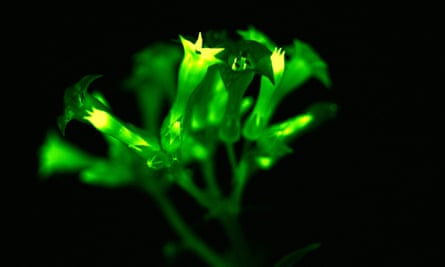Emitting an eerie green glow, they look like foliage from a retro computer game, but in fact they are light-emitting plants produced in a laboratory.
Researchers say the glowing greenery could not only add an unusual dimension to home decor but also open up a fresh way for scientists to explore the inner workings of plants.
“In the future this technology can be used to visualise activities of different hormones inside the plants over the lifetime of the plant in different tissues, absolutely non-invasively. It can also be used to monitor plant responses to various stresses and changes in the environment, such as drought or wounding by herbivores,” said Dr Karen Sarkisyan, the CEO of Planta, the startup that led the work, and a researcher at Imperial College London.
“We really hope to bring this to the market in a few years from now, once we make them a bit brighter, once we make the ornamental plants with this new technology, and once of course they pass all the existing safety regulations,” he added.
Numerous animals, microbes and mushrooms – from fireflies to honey fungi – can glow, a phenomenon known as bioluminescence. This occurs when enzymes act on chemicals known as luciferins within the organism, resulting in energy being released in the form of light. However, bioluminescence does not crop up naturally among plants.
The latest research is not the first time scientists have created glowing greenery – a development that has led to suggestions of everything from plant-based street lights to self-illuminating Christmas trees. Among previous approaches, researchers have delivered both luciferins and the enzymes necessary for bioluminescence into plants via nanoparticles, while other teams have incorporated bacterial genes for bioluminescence into plants.
However, these approaches have had drawbacks: the delivery of a luciferin on tiny particles is more expensive and is not self-sustained, while the incorporation of bacterial bioluminescence genes involves a cumbersome process that results in only a weak glow. What’s more, said Sarkisyan, the latter approach appears to be toxic to plants.
The new research takes a different tack, harnessing the recently discovered process by which fungi emit light. The team say that is important as the process involves a luciferin produced from a chemical that is naturally present in plants – caffeic acid.
Writing in the journal Nature Biotechnology, Sarkisyan and a team of colleagues based in Russia and Austria report how they inserted four genes from a bioluminescent mushroom called Neonothopanus nambi into the DNA of tobacco plants. These genes relate to enzymes that convert caffeic acid, through a series of steps, into a luciferin that emits energy as light, before turning the resulting substance back into caffeic acid.
The upshot is plants that glow with a greenish hue visible to the naked eye. “They glow both in the dark and in the daylight,” said Sarkisyan, adding that the light appeared to be 10 times brighter than that produced by using bacterial genes.
The team found the site of the luminescence changed as the plants grew, and luminescence generally decreased as leaves aged and increased where leaves became damaged. Flowers produced the most luminescence, the team report.

Sarkisyan said that in the future the team could insert the fungal genes into the plant’s DNA near genes that were activated by certain hormones. “You should be able to see the light coming only from the tissues where the hormone is currently active,” he said.
Gary Foster, a professor in molecular plant pathology at the University of Bristol, who was not involved in the research, said the glowing plants would mainly be used by scientists rather than for applications such as plant-based street lights, but were nonetheless welcome.
“Many luminescent marker genes have up until now required special light sources and/or cameras to visualise the location of expression. The system reported here will make that process easier,” he said.
Prof John Carr, from the University of Cambridge, also welcomed the work, but said there was more to be done. “The challenge now is to figure out how to make this engineered bioluminescence responsive to specific environmental, developmental, chemical or pathogenic stimuli,” he said. “This is essential if the technique will, literally, be able to throw new light on fundamental biological processes.”
